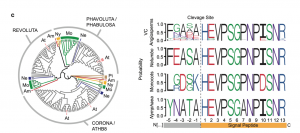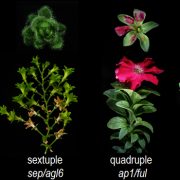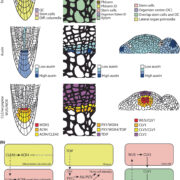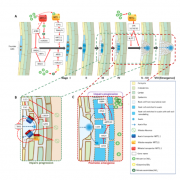Water lily (Nymphaea thermarum) draft genome reveals variable genomic signatures of ancient cambium losses (bioRxiv)
 The vascular cambium, a meristematic tissue responsible for xylem and phloem production, is an ancestral trait in angiosperms, however, its loss has independently occurred in at least 5 flowering plant lineages. One of such is the Nymphaeales, which includes Nymphaea thermarum, an emergent model for early flowering plant evolution. Studies in several species have determined that the CLAVATA (CLE) signaling peptides, as well as redundantly-acting transcription factors of HD-ZIP III family, are necessary for secondary vascular differentiation. Although the molecular players required are known, the convergent loss of the vascular cambium poses the question of how pleiotropic and redundant genes evolve in the context of vascular cambium loss. In this study, Povilus et al. deciphered the N. thermarum genome, and by comparing it to genomes from cambium-bearing and cambium-less species, detected contraction of the HD-ZIP lll family in several cambium-less lineages. Specifically, loss of the REVOLUTA transcription factor, a known regulator of cambial initiation and xylem fiber differentiation, was observed in N. thermarum. In addition, the authors observed sequence divergence of essential residues in vascular-development associated CLE peptides from several cambium-less lineages. This study contributes to the understanding of how different genomic signatures between lineages may translate in homoplasious events, such as the loss of the vascular cambium, and provides a valuable resource for the study of early diverging angiosperms. (Summary by Jesus Leon) bioRxiv [altmetric doi=”10.1101/2019.12.18.881573″ details=”right” float=”right”]
The vascular cambium, a meristematic tissue responsible for xylem and phloem production, is an ancestral trait in angiosperms, however, its loss has independently occurred in at least 5 flowering plant lineages. One of such is the Nymphaeales, which includes Nymphaea thermarum, an emergent model for early flowering plant evolution. Studies in several species have determined that the CLAVATA (CLE) signaling peptides, as well as redundantly-acting transcription factors of HD-ZIP III family, are necessary for secondary vascular differentiation. Although the molecular players required are known, the convergent loss of the vascular cambium poses the question of how pleiotropic and redundant genes evolve in the context of vascular cambium loss. In this study, Povilus et al. deciphered the N. thermarum genome, and by comparing it to genomes from cambium-bearing and cambium-less species, detected contraction of the HD-ZIP lll family in several cambium-less lineages. Specifically, loss of the REVOLUTA transcription factor, a known regulator of cambial initiation and xylem fiber differentiation, was observed in N. thermarum. In addition, the authors observed sequence divergence of essential residues in vascular-development associated CLE peptides from several cambium-less lineages. This study contributes to the understanding of how different genomic signatures between lineages may translate in homoplasious events, such as the loss of the vascular cambium, and provides a valuable resource for the study of early diverging angiosperms. (Summary by Jesus Leon) bioRxiv [altmetric doi=”10.1101/2019.12.18.881573″ details=”right” float=”right”]









